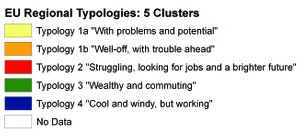91 regions "with problems and potential" (1a)
Two groups of regions with low exposure to rising energy prices for industry: the service-oriented urban centres (the heart of the Pentagon) and semi-rural, often tourist-oriented coastal and island regions in the south of Europe. The high photovoltaic (PV) potential of many of the regions in this latter group is an important asset for the future and could help to ease the strain of the need for cooling in the summer time. However, the capital areas must be prepared for possible changes in transport patterns as a result of rising energy prices, both in terms of commuting (incoming labour) and loss of traffic volumes in the transport hubs. In addition, the higher than average unemployment rates witnessed in 2007 are an indicator of the emergence of social problems in both the semi-rural and capital areas.
73 regions "well-off but with trouble ahead" (1b)
These are central, industrialised regions, including the more industrial coastal (harbour) and Pentagon areas, with a low potential for the development of wind and solar energy. The competitiveness of these regions could be severely affected by rising energy prices if efforts to improve energy efficiency in industry and transport fail, but their starting position is much more favourable than that of regions grouped in typology 2.
47 regions "looking for jobs and a brighter future" (2)
The most vulnerable regions in terms of social cohesion, located mainly in Eastern Europe, with high energy demand both for heating and cooling. These mostly peripheral regions do have potential to develop renewable energy systems, but lack the resources to do so.
15 regions are "wealthy and commuting" (3)
Mostly regions belonging to the Pentagon "hinterland", in which wealth creation is dependent on accessing near-by centres of economic growth. The main challenge related to rising energy prices in these regions is that of guaranteeing affordable mobility. There is a high potential for polycentric development in these regions, but fewer possibilities for using wind and solar power.
11 regions are "cool and windy, but working" (4)
The greatest concern is the heavy industrial base, combined with extreme peripheral location on the coastline and the high energy demand for heating in these, mostly Nordic, regions. Opportunities for the further development of wind energy are however considerable while the risk of energy poverty in households will remain low as long as the job situation remains as it was in 2007.
By Daniela Velte, Senior Researcher, Tecnalia



EUROPEAN UNION
Part-financed by the European Regional Development Fund
INVESTING IN YOUR FUTURE
Regional level: NUTS II
Source: ESPON ReRisk, 2010
Origin of data: Own elaboration, 2010
© EuriGeographics Association for administrative boundaries